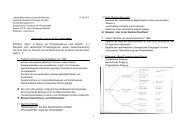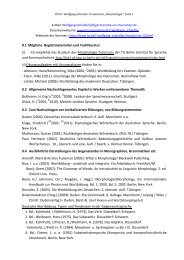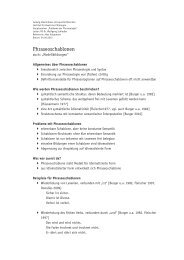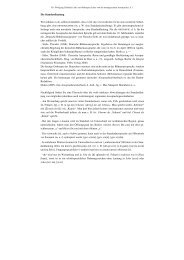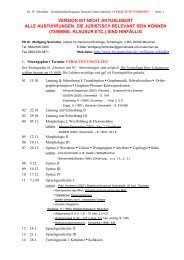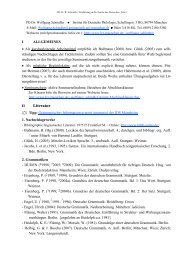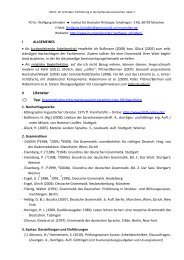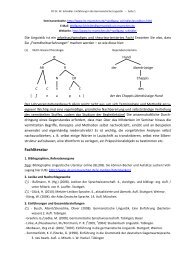Chapter 18 Lexical Functions: Description of Lexical Relations in a ...
Chapter 18 Lexical Functions: Description of Lexical Relations in a ...
Chapter 18 Lexical Functions: Description of Lexical Relations in a ...
Create successful ePaper yourself
Turn your PDF publications into a flip-book with our unique Google optimized e-Paper software.
LF-Sem-Rule 3<br />
(<strong>in</strong>tensely)<br />
1<br />
!<br />
—<strong>Chapter</strong> <strong>18</strong>. <strong>Lexical</strong> <strong>Functions</strong>— 86<br />
L(P)<br />
ATTR<br />
(P) Magn<br />
The mean<strong>in</strong>g (<strong>in</strong>tensely P) is expressed<br />
by a Magn modify<strong>in</strong>g the LU L(P) that<br />
lexicalizes the mean<strong>in</strong>g (P).<br />
There are also other sources for Magn, but these examples seem to be sufficient here.<br />
3. The LF Real 3:<br />
LF-Sem-Rule 4<br />
(P) " (prescription)<br />
2 3<br />
1<br />
(Y) (Z)<br />
example.<br />
!<br />
L(Z)<br />
Real 3<br />
I II<br />
II<br />
L(Y)<br />
L(P)<br />
The mean<strong>in</strong>g (Z does Y that some-<br />
one’s prescription P tells him to do)<br />
can be expressed by a Real 3,<br />
applied to the noun L(P) that<br />
lexicalizes the mean<strong>in</strong>g (P).<br />
The LF Real i has other semantic sources, too; but as above, I will limit myself to one<br />
Where subtler mean<strong>in</strong>g dist<strong>in</strong>ctions concern<strong>in</strong>g LFs are needed, semantic dist<strong>in</strong>guishers,<br />
superscripts and other devices, as presented above, are used.<br />
Accord<strong>in</strong>g to the given def<strong>in</strong>itions, the LFs are selected, <strong>in</strong> the process <strong>of</strong> synthesis, and<br />
<strong>in</strong>serted <strong>in</strong>to the DSyntS <strong>of</strong> the sentence be<strong>in</strong>g constructed—very much like all other Deep<br />
<strong>Lexical</strong> Units. 25<br />
6.2. Phraseological Aspect <strong>of</strong> <strong>Lexical</strong> <strong>Functions</strong><br />
6.2.1. Graduality <strong>of</strong> Restrictedness <strong>of</strong> LF Expressions<br />
In some cases, an element <strong>of</strong> the value <strong>of</strong> a given LF f is highly idiosyncratic: e.g., pay<br />
ATTENTION, where PAY = Oper 1(attention) is a rare choice. But <strong>in</strong> numerous other cases elements<br />
<strong>of</strong> an LF are not idiosyncratic at all: for example, attract X’s ATTENTION, where ATTRACT =<br />
Caus 2Func 2(attention) is semantically completely motivated. However, this expression still must<br />
be described by a lexical function: with some other nouns, you cannot use attract <strong>in</strong> order to


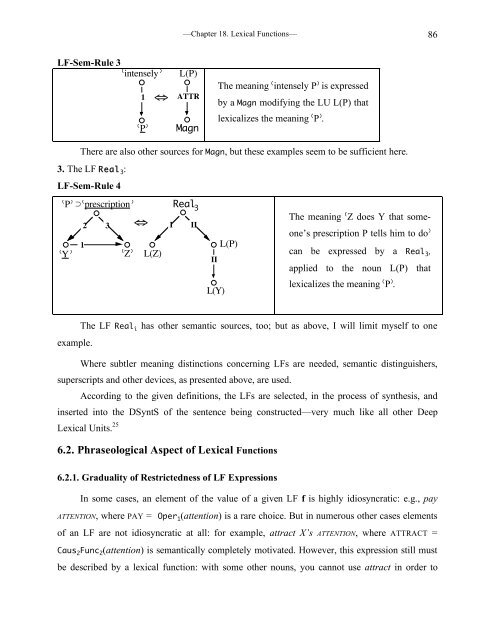
![E-Mail: Wolfgang.Schindler[ätt]germanistik.uni-muenchen.de Web ...](https://img.yumpu.com/51590147/1/184x260/e-mail-wolfgangschindlerattgermanistikuni-muenchende-web-.jpg?quality=85)
